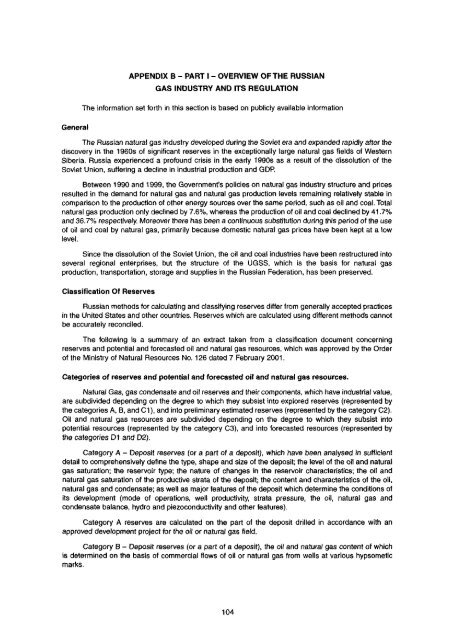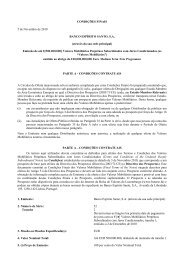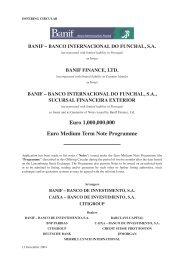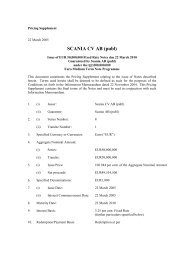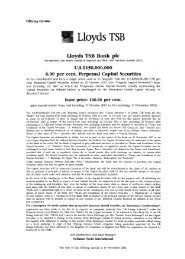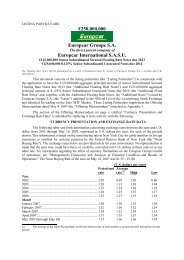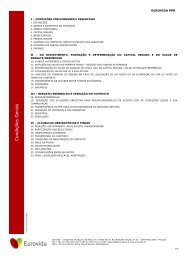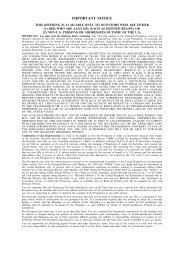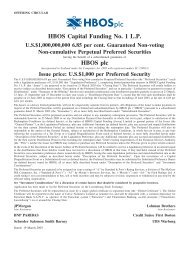GeneralAPPENDIX B – PART 1 – OVERVIEW OF THE RUSSIANGAS INDUSTRY AND ITS REGULATIONThe information set forth in this section is based on publicly available informationThe Russian natural gas industry developed during the Soviet era and expanded rapidly after thediscovery in the 1960s of significant reserves in the exceptionally large natural gas fields of WesternSiberia. Russia experienced a profound crisis in the early 1990s as a result of the dissolution of theSoviet Union, suffering a decline in industrial production and GDP.Between 1990 and 1999, the Government's policies on natural gas industry structure and pricesresulted in the demand for natural gas and natural gas production levels remaining relatively stable incomparison to the production of other energy sources over the same period, such as oil and coal. Totalnatural gas production only declined by 7.6%, whereas the production of oil and coal declined by 41.7%and 36.7% respectively. Moreover there has been a continuous substitution during this period of the useof oil and coal by natural gas, primarily because domestic natural gas prices have been kept at a lowlevel.Since the dissolution of the Soviet Union, the oil and coal industries have been restructured intoseveral regional enterprises, but the structure of the UGSS, which is the basis for natural gasproduction, transportation, storage and supplies in the Russian Federation, has been preserved.Classification Of ReservesRussian methods for calculating and classifying reserves differ from generally accepted practicesin the United States and other countries. Reserves which are calculated using different methods cannotbe accurately reconciled.The following is a summary of an extract taken from a classification document concerningreserves and potential and forecasted oil and natural gas resources, which was approved by the Orderof the Ministry of Natural Resources No. 126 dated 7 February 2001.Categories of reserves and potential and forecasted oil and natural gas resources.Natural Gas, gas condensate and oil reserves and their components, which have industrial value,are subdivided depending on the degree to which they subsist into explored reserves (represented bythe categories A, B, and C1), and into preliminary estimated reserves (represented by the category C2).Oil and natural gas resources are subdivided depending on the degree to which they subsist intopotential resources (represented by the category C3), and into forecasted resources (represented bythe categories D1 and D2).Category A – Deposit reserves (or a part of a deposit), which have been analysed in sufficientdetail to comprehensively define the type, shape and size of the deposit; the level of the oil and naturalgas saturation; the reservoir type; the nature of changes in the reservoir characteristics; the oil andnatural gas saturation of the productive strata of the deposit; the content and characteristics of the oil,natural gas and condensate; as well as major features of the deposit which determine the conditions ofits development (mode of operations, well productivity, strata pressure, the oil, natural gas andcondensate balance, hydro and piezoconductivity and other features).Category A reserves are calculated on the part of the deposit drilled in accordance with anapproved development project for the oil or natural gas field.Category B – Deposit reserves (or a part of a deposit), the oil and natural gas content of whichis determined on the basis of commercial flows of oil or natural gas from wells at various hypsometicmarks.104
The type, shape and size of the deposit; the level of the oil and natural gas saturation; thereservoir type; the nature of changes in the characteristics of the reservoir; the oil and natural gassaturation of the productive strata; the content and characteristics of the oil, natural gas and condensateunder stratum, standard conditions and other parameters; and also other major features of the depositwhich define the conditions for its development, are all analysed so as to enable a deposit developmentproject to be drawn up.Category B reserves are calculated on the part of a deposit drilled in accordance with either anapproved technological development scheme for an oil field or a trial industrial development project fora natural gas field.Category C1 deposit reserves (or a part of a deposit), the oil and natural gas content of which isdeter-mined on the basis of commercial flows of oil or natural gas from wells (a number of wells areprobed by exploration drilling) and on the basis of positive results from geological and geophysicalanalyses of untested wells. The type, shape and size of the deposit, and the conditions for bedding theoil and natural gas bearing reservoir are determined by the results of drilling exploratory and operationalwells and are verified by approved methods for a given region and by geological and geophysicalanalytical methods.The lithological content, the reservoir type and characteristics, the oil and natural gas saturation,the oil displacement rate, and the level of the oil and natural gas saturation of the productive strata, aredetermined through an analysis of the core and materials from geophysical well testing. The content andcharacteristics of the oil, natural gas and condensate under stratum and standard conditions areanalysed according to test data from the wells. The commercial value of the oil "edge" is determined bythe oil and natural gas deposit. Well productivity, hydroconductivity and piezoconductivity of the stratum,stratum pressure, temperature, and the oil, natural gas and condensate balance are analysed throughtesting and studies of the wells. The hydrogeological and geocryological conditions are determined bythe results of well drilling and through comparison with neighbouring explored fields.Category C1 reserves are calculated on results of geological exploratory work and productiondrilling. They are analysed in order to enable preliminary data to be drawn up for a technologicaldevelopment plan for an oil field, or for a project for the trial industrial development of a natural gas field.Category C2 preliminary estimated reserves – reserves of a deposit (part of a deposit), whichavail-ability is based on the results of geological and geophysical research in the unexplored part of thedeposit ad-joining plots containing reserves of higher categories and in the untested deposits of theexplored fields. The shape and the size of the deposit. Conditions of bedding, level and reservoir typesof the layers, content and characteristics of oil, gas and condensate are determined in general termsbased on the results of geological and geophysical exploration subject to information on a betterexplored part of the deposit or by analogy with the explored fields.Category C2 reserves are used to determine perspectives of the field and planning of geologicaland exploration works and geological and production exploration upon the transfer of wells to the higherlayers. Category C2 reserves are partially used for the purposes of compiling project documentation forthe development of the deposits.RegulationThe Russian legal system's rapid evolution during the last ten years is particularly evident in thecontext of natural gas industry regulation. Below is a brief overview of some key aspects of currentregulatory requirements in the natural gas industry.The regulation of legal and economic relations in the Russian natural gas industry is mainlybased on the Constitution of the Russian Federation, the Civil Code of the Russian Federation, the Lawof the Russian Federation "On Subsoil Resources" No. 2395-1 dated 21 February 1992 as amended(the "Subsoil Resources Law"), the Federal Law "On Natural Monopolies" No. 147-FZ dated 17 August1995 as amended (the "Natural Monopoly Law"), the Federal Law "On the Continental Shelf of theRussian Federation" No. 187-FZ dated 30 November 1995 as amended and the Gas Supply Law. The105
- Page 1:
OFFERING CIRCULARJOINT-STOCKCOMPANY
- Page 4 and 5:
classifications and methodologies,
- Page 6 and 7:
INVESTMENT CONSIDERATIONSAn investm
- Page 8 and 9:
Relationship with the GovernmentThe
- Page 10 and 11:
elation to its assets and operation
- Page 12 and 13:
Ethnic and religious differences in
- Page 14 and 15:
TRANSACTION SUMMARYThe transaction
- Page 16 and 17:
SELECTED FINANCIAL INFORMATIONThe s
- Page 18 and 19:
CAPITALISATIONThe following table s
- Page 20 and 21:
OAO GAZPROMPrivatisation and Format
- Page 22 and 23:
Gazprom Shares. The Presidential De
- Page 24 and 25:
Gazprom's main subsidiaries were, a
- Page 26 and 27:
Management StructureIn accordance w
- Page 28 and 29:
The current membership of Gazprom's
- Page 30 and 31:
1999 2000 2001(mtoe, except for per
- Page 32 and 33:
Central and Eastern EuropeGazprom e
- Page 34 and 35:
U.S.$43 million and from those cust
- Page 36 and 37:
Country% OFEUROPEANNATURALGAS SUPPL
- Page 38 and 39:
As at 31 December 2000, proved and
- Page 40 and 41:
The following table sets out, as at
- Page 42 and 43:
een put on stream at the Astrakhans
- Page 44 and 45:
Orenburg Helium Plant. This is Russ
- Page 46 and 47:
The following table sets forth some
- Page 48 and 49:
Gazprom provides the independent su
- Page 50 and 51:
INTERNATIONAL PROJECTS AND ALLIANCE
- Page 52 and 53:
major natural gas distributor in ea
- Page 54 and 55: Other foreign associate undertaking
- Page 56 and 57: Gazprom has developed and continues
- Page 58 and 59: LOAN AGREEMENTThe following is the
- Page 60 and 61: "Notes" means the U.S.$500,000,000
- Page 62 and 63: "Subsidiary" means, with respect to
- Page 64 and 65: 5 Repayment and Prepayment5.1 Repay
- Page 66 and 67: the amount of any such payment and
- Page 68 and 69: necessary to compensate the Bank fo
- Page 70 and 71: 9.1.15 In any proceedings taken in
- Page 72 and 73: 10.6 Payment of Taxes and Other Cla
- Page 74 and 75: ankruptcy law, or (iii) a bankruptc
- Page 76 and 77: execution of this Agreement and all
- Page 78 and 79: 14.8 Contracts (Rights of Third Par
- Page 80 and 81: TERMS AND CONDITIONS OF THE NOTESTh
- Page 82 and 83: Under the Trust Deed, the obligatio
- Page 84 and 85: Payments of interest shall be made
- Page 86 and 87: The Trustee may agree, without the
- Page 88 and 89: SUMMARY OF PROVISIONS RELATING TO T
- Page 90 and 91: circumstances, if the disposal proc
- Page 92 and 93: SALOMON BROTHERS AGThe Bank is lice
- Page 94 and 95: GENERAL INFORMATION1. The Notes rep
- Page 96 and 97: force is being formed to gradually
- Page 98 and 99: to address these pressures. First,
- Page 100 and 101: Balance of PaymentsThe following ta
- Page 102 and 103: understanding that it would serve a
- Page 106 and 107: most important recent piece of legi
- Page 108 and 109: integrated objects managed on a cen
- Page 110 and 111: • price regulation - setting pric
- Page 112 and 113: APPENDIX B — PART II — EXTRACT
- Page 114 and 115: APPENDIX C - GLOSSARY OF TERMS"Acco
- Page 116 and 117: "State Gas Concern Gazprom"the Stat
- Page 118 and 119: OAO GAZPROMIAS CONSOLIDATED FINANCI
- Page 120 and 121: OAO GAZPROMIAS CONSOLIDATED BALANCE
- Page 122 and 123: OAO GAZPROMIAS CONSOLIDATED STATEME
- Page 124 and 125: OAO GAZPROMNOTES TO THE IAS CONSOLI
- Page 126 and 127: OAO GAZPROMNOTES TO THE IAS CONSOLI
- Page 128 and 129: OAO GAZPROMNOTES TO THE IAS CONSOLI
- Page 130 and 131: OAO GAZPROMNOTES TO THE IAS CONSOLI
- Page 132 and 133: OAO GAZPROMNOTES TO THE IAS CONSOLI
- Page 134 and 135: OAO GAZPROMNOTES TO THE IAS CONSOLI
- Page 136 and 137: OAO GAZPROMNOTES TO THE IAS CONSOLI
- Page 138 and 139: OAO GAZPROMNOTES TO THE IAS CONSOLI
- Page 140 and 141: OAO GAZPROMNOTES TO THE IAS CONSOLI
- Page 142 and 143: OAO GAZPROMNOTES TO THE IAS CONSOLI
- Page 144 and 145: OAO GAZPROMNOTES TO THE IAS CONSOLI
- Page 146 and 147: OAO GAZPROMNOTES TO THE IAS CONSOLI
- Page 148 and 149: OAO GAZPROMNOTES TO THE IAS CONSOLI
- Page 150 and 151: OAO GAZPROMNOTES TO THE IAS CONSOLI
- Page 152 and 153: OAO GAZPROMNOTES TO THE IAS CONSOLI
- Page 154 and 155:
OAO GAZPROMNOTES TO THE IAS CONSOLI
- Page 156 and 157:
OAO GAZPROMNOTES TO THE IAS CONSOLI
- Page 158 and 159:
PRlCEWATERHOUSECOOPERSZAO Pricewate
- Page 160 and 161:
OAO GAZPROMIAS CONSOLIDATED STATEME
- Page 162 and 163:
OAO GAZPROMIAS CONSOLIDATED STATEME
- Page 164 and 165:
OAO GAZPROMNOTES TO THE IAS CONSOLI
- Page 166 and 167:
OAO GAZPROMNOTES TO THE IAS CONSOLI
- Page 168 and 169:
OAO GAZPROMNOTES TO THE IAS CONSOLI
- Page 170 and 171:
OAO GAZPROMNOTES TO THE IAS CONSOLI
- Page 172 and 173:
OAO GAZPROMNOTES TO THE IAS CONSOLI
- Page 174 and 175:
OAO GAZPROMNOTES TO THE IAS CONSOLI
- Page 176 and 177:
OAO GAZPROMNOTES TO THE IAS CONSOLI
- Page 178 and 179:
OAO GAZPROMNOTES TO THE IAS CONSOLI
- Page 180 and 181:
OAO GAZPROMNOTES TO THE IAS CONSOLI
- Page 182 and 183:
OAO GAZPROMNOTES TO THE IAS CONSOLI
- Page 184 and 185:
OAO GAZPROMNOTES TO THE IAS CONSOLI
- Page 186 and 187:
OAO GAZPROMNOTES TO THE IAS CONSOLI
- Page 188 and 189:
OAO GAZPROMNOTES TO THE IAS CONSOLI
- Page 190 and 191:
OAO GAZPROMNOTES TO THE IAS CONSOLI
- Page 192 and 193:
OAO GAZPROMNOTES TO THE IAS CONSOLI
- Page 194 and 195:
OAO GAZPROMNOTES TO THE IAS CONSOLI
- Page 196 and 197:
OAO GAZPROMNOTES TO THE IAS CONSOLI
- Page 198 and 199:
OAO GAZPROMNOTES TO THE IAS CONSOLI
- Page 200 and 201:
OAO GAZPROMNOTES TO THE IAS CONSOLI
- Page 202 and 203:
OAO GAZPROMINVESTOR RELATIONSThe Co
- Page 204 and 205:
LEGAL ADVISERSTo the CompanyAs to R
- Page 206:
printed by eprintfinancial.comtel:


